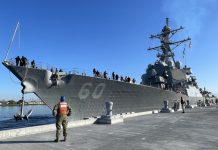In 2012, the U.S. Army Reserve Center on the Joint Forces Training Base received a new headquarters. The building houses the 79th Sustainment Support Command, the second largest Army Reserve command.
Recently, that new building was dedicated to a California reserve soldier who gave his life while trying to help an injured soldier
just south of Baghdad in 2003. Sergeant Paul Tokuzo Nakamura was killed by insurgents while aiding and transporting a wounded soldier as part of the 437th Medical Company in Camp Arifjan.
Now, the building that is such an important component in the Army Reserve’s operations is known as the Sgt. Paul T. Nakamura United States Army Reserve Center. At the June 21 dedication ceremony, 79th Sustainment Support Commanding General Megan Tatu said that the honoring of Nakamura was essentially an easy decision because of his representation of the Army Reserves.
“By all accounts, he was the embodiment of the civilian warrior [commander’s] all hope to have,” Tatu said.
Nakamura was a native of Santa Fe Springs, where he grew up, attended school and was a big part of the city’s aquatics program. He excelled at high school wrestling, water polo and swimming and was an instructor at the aquatics center. Santa Fe Springs Mayor, Juanita Trujillo was also in attendance and presented the Nakamura family with proclamation from the city.
Growing up, Nakamura was active in Boy Scouts, surfing and Jr. Lifeguards. He loved classic cars, playing pool and video games. But he also had a sense of purpose and wanted to serve his country. In 1999, he enlisted in the Army Reserves. Those who knew him said he liked to joke and have fun; that he was laid back and easy going, but that he could also get jobs done when necessary.
One of his fellow soldiers, Sgt. Cory Caranza was the driver of the ambulance on the day that Nakamura was killed. Caranza was injured in the attack. He recalled Nakamura as the voice of calm and reason in their unit, the guy who could figure out how to get things done without stress and panic.
While having only known Nakamura for the last two years of his life, Caranza said that even now, 11 years later, he remains a fixture in his life. One of Caranza’s small children is named Paul.
“The impact that he has had on my life since then has been tremendous,” Caranza said.
Major Robert Ostenberg (Ret.) delivered the Commander’s Tribute at the ceremony. He spoke of the improvement in the survival rate of soldiers in combat since the Vietnam era and how that can be attributed to the efforts and training of medical providers such as Nakamura.
Ostenberg noted that the first hour of aid can make a huge difference in the survival of a wounded soldier. Among the commendations that Nakamura received included the Combat Medical Badge, National Defense Service Medal, Bronze Star and Purple Heart.
“Paul lived a great life, a short life, but an inspirational life,” Ostenberg said.
About the Building
- The Sgt. Paul T. Nakamura U.S. Army Reserve Center was constructed at a cost of $12.9 million, with site preparation and solar panels costing $6.2 million.
- The project was completed and turned over to the U.S. Army Reserve in December of 2012.
- The center is 53,000 square feet of training, administration and public space, including a kitchen, fitness center, showers, classrooms and multipurpose assembly area.
- The complex was undertaken as a direct part of the “Grow the Army” initiative to increase the size of the Army to support the demands from the Global War on Terrorism.
- It was designed and constructed to achieve a Leadership in Energy and Environmental Design (LEED) Gold Rating.
- The center is home to approximately 200 soldiers, civilians and contractors.











